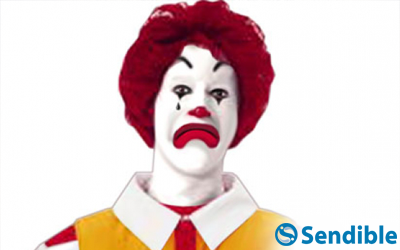
A question for you: why has the McDonald's corporation been able to sustain dominance in the restaurant world for so many decades on end? Is it because they serve the best food? The answer to that should be an obvious "Not even close". You would be hard-pressed to find anyone who would choose a McDonald's burger over any other burger given the side-by-side choice. Even other fast-food restaurants like Hardees would handily beat them out, especially in a blind taste test.
Yet there is no doubt that Mickey D's is the undisputed king of burger sales, so how do they do it? There are two answers. First, they basically invented franchising and have opened more outlets through that method than any other restaurant in history. Second, and perhaps more importantly, they gear their advertising towards the younger generation. Not every restaurant can franchise out or put a new location every few blocks globally, but when it comes to reaching out to the young crowd the door is open and waiting for you to walk through.
Food + Social Media + Millennials = $$$
The Millennial generation spends around $250 billion per year at restaurants, which is a pie that you want a piece of. They rely on word-of-mouth suggestions for local eats, and they use review sites like Yelp when they are in an unfamiliar town. As of last year, they check in at restaurants with Instagram even more than they do with Foursquare, and they love to post pictures of their meals. Over 30% check the menus from their smartphones before they go. And the biggie: over two-thirds of them take social media conversations about a restaurant into consideration when they are deciding where to eat.

Add to this formula the fact that Millennials eat in large groups more than any other demographic group, and the point becomes pretty obvious: restaurants need to be doing social media well. Why the emphasis on Millennials? If it isn't obvious, they're going to be around a lot longer than Gen X or the Boomers, and they are quickly becoming the primary spending power in the world. It's time to find out how to slice a bigger piece of the pie from them.
Tell a Story
Engaging with your followers and fans is obviously a given, but there are certain aspects of engagement that make a difference much more than others. For example, today's consumers want more than just a product list and a coupon (not that these should be ignored). They react much better to an overarching story and to involvement beyond the walls of your restaurant. The most notable and obvious example of this over the last decade has been Starbucks.
More recently, the meteoric rise of Chipotle shows us how this strategy works. Chipotle is committed to "food with integrity", using organic, sustainable, and local ingredients whenever possible and practical. This has resonated with the younger, more socially conscious generation. Beyond just a slogan or even a practice, Chipotle actively promotes this theme using social media. Their Facebook page displays calendar events when they will go to visit farmer's markets to buy ingredients. They also promote and sponsor the Cultivate Festival, a traveling outdoor event for food, music, and ideas, and post pictures of the events on their page.
They also post their food pictures (and others) on Pinterest, the fastest growing and second largest social network today. Every restaurant should have a Pinterest account where they at the very least showcase their menu items. The New York restaurant Comodo encourages their patrons to post pictures of their dishes on Instagram before they eat it, creating a customer-based visual menu that is full of recommendations by default. This also would let you keep a pulse of what should be kept or removed from the menu.
Eateries like Pinkberry frozen yogurt and Nando's chicken are masters of the response, even if the other party wasn't expecting one. They daily and actively respond not only to direct tweets and comments, they also monitor social media for restaurants through keywords and brand mentions looking for opportunities to respond. Proactive responses are viewed as authentic engagement rather than obligatory service, and it's that kind of interaction that creates brand loyalty.
Perks and Promotions
The last several years of a poor global economy have ingrained a sense of thriftiness into people, particularly into Millennials. They gravitate towards discounts and offers. Sunda, an Asian restaurant in Chicago, offers weekly special as well through their social media accounts. They also offer loyalty discounts such as a free appetizer after three Foursquare check-ins, as well as surprise flash promotions like a discount for the first ten check-ins at lunch on a given day. Over 40% of Millennials say that coupons and discounts are important when deciding where they will eat.
Online Customer Service
@samanthalomax Hi Samantha, just checking to see if your visit went okay tonight? Any issues, please let us know - social@pizzaexpress.com
— PizzaExpress (@PizzaExpress) August 17, 2014
Customers expect you to have online customer service through social media. It's just become the norm. When I had an issue with my smartphone several months ago, I took to the customer service Twitter account for my carrier. Although the issue wasn't resolved that way, I had a response and a back-and-forth conversation that helped greatly within a couple of hours. Every business should adopt this strategy.
Your restaurant (and every business, imho) should have a dedicated Twitter account for customer service. It is the quickest and easiest way to handle most issues, and it will create loyalty and satisfaction more often than it will problems. Significantly, 83% of social customers will abandon a purchase or a business due to poor customer service. If you can ignore a statistic that high, you might as well give up now.

